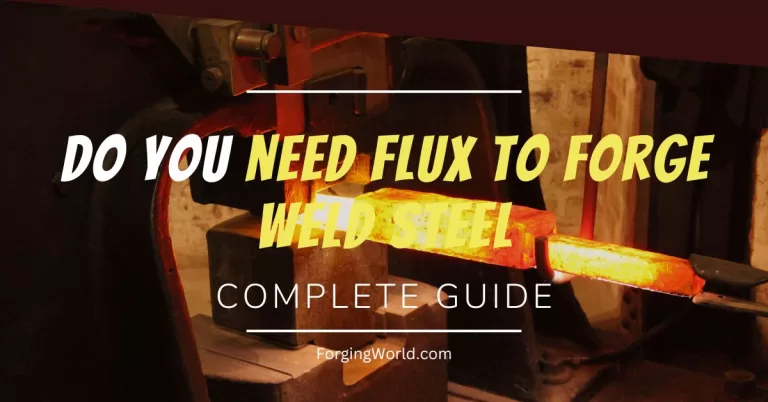Blacksmithing is one of the longest-established crafts. You can build almost any project out of metal. In the early 20th century, before the Great Depression, there was a good age for smiths who made architectural projects. However, when the time of the Great Depression started, blacksmithing was slowly disappearing. Then the industrial era began with new machines and technologies that put many blacksmiths out of business.
So, is blacksmithing a dying art? While blacksmithing may not be as popular in the past, it is still not a dying art. Moreover, blacksmithing is a growing trend in recent years, thanks to more and more young guys getting started. The current tv show “Forged in Fire” raised this industry tremendously in the last couple of years.
Let’s find out how blacksmithing evolved over the years up to this point. We will also discuss the future of blacksmithing and whether you should be thinking about getting started.
How Is It Possible That Blacksmithing Is Still Popular in 2020?
The tv show, Forged in Fire, had one of the biggest positive impacts on the forging industry. Since this show started in 2015, thousands of people began their blacksmithing journey since then. The Year 2015 was a turning point in this industry. We see new youtube channels, blogs, courses, and blacksmithing every year due to the increasing interest.
In each episode of the show, a few people compete in a three-round elimination competition. The goal is to forge the best quality blade. The winner takes home 10,000$ and the title of champion. The most common project in this show are swords and knives, so bladesmithing, in particular, attracts more and more attention in recent years.
Another factor that had a massive impact on the blacksmithing industry is the growth of social networks like Instagram and Youtube. With millions of users, it is no wonder that blacksmithing became popular. While Instagram is a popular platform for showing the arts of talented blacksmiths, Youtube became one of the best platforms to learn about this craft.
Also, many new blacksmithing classes emerged in recent years. Everyone interested in starting this craft, we highly recommend attending the class. In one day of the course, you can learn more than in a month watching youtube videos. The best practice is when you are actually hammering the hot metal by yourself, not when you watch someone else doing it.
Another problem with starting on your own is that you don’t have anyone to correct you when you make a mistake. So you can easily continue working without realizing you are making a mistake. In classes, you always have an experienced blacksmith who corrects you immediately. Directly learning from a skilled blacksmith is the most valuable thing when you are a beginner.
You can find classes like this in almost every state of North America and also Europe. Keep in mind that if you cannot visit the courses in person, you can always check the online version. While for some things, the online version may be better, this is definitely not the case here. Unlike language or some school subjects, blacksmithing is done with your hands, not on the computer. So, if you have a chance to sign-up for an in-person blacksmithing class, do it.
When Did Blacksmiths Become Obsolete?
The craft of blacksmithing originates back to 1500 B.C. when Hittites learned the process of forging and tempering in the area of today’s Turkey. Ancient blacksmithing was very unpredictable, primarily due to the lack of knowledge about iron properties. So, it is logical to conclude that not every workpiece was of a good quality.
Most of the work was either brittle or too soft to retain sharp edges. When the Iron Age began, wrought iron developed slowly. It was harder and tougher than the regular iron. In the Medieval Period, blacksmiths were considered essential for everyday life. Every village had at least one blacksmith. In most town villages, they were highly positioned people in the community.
However, in some villages, they were considered nothing but workers and sometimes even evil due to the essence of their job. Things like tools, armor, weapons, and various household objects were made by blacksmiths that developed advanced techniques.
We could say that at the beginning of the Industrial Era, blacksmithing started to decline in popularity. Namely, with the introduction of the Industrial Era, many blacksmiths disappeared from the market. As advancing technology and new machinery were developing, it soon started to replace blacksmiths. This is the reason why a lot of them transitioned into automobile mechanics.
But at the beginning of the 20th century, before the start of the Great Depression, we can say that blacksmithing was on the rise again, especially for those who produced architectural ironwork. These works are known and appreciated even today. Industrialization, combined with the Great Depression, has led this craft to imminent extinction through much of the 20th century.
Blacksmithing developed again in the 1970s when interest started to increase. From an essential part of daily life, blacksmithing became a community of artists and those who specialized in traditional forging techniques. Since that time, this industry is always increasing. Today you have more opportunities to learn blacksmithing than ever before.
Thoughts on the Future of Blacksmithing
The blacksmithing industry so far sees no signs of imminent extinction. Since the 70s, the craft is in constant growth, so if you are thinking about starting a blacksmithing business or even just a hobby, it is a good time. One more reason I believe that blacksmithing won’t extinguish any time soon is that nothing can beat handmade work. Take knives, for example.
There is a reason why some of the manually forged knives cost a couple of thousands of dollars. The truth is, when you buy a custom knife or some other item, you buy the art of a highly skilled person. Items made in the factory will never be valuable as the work of a blacksmith.
How to Start Blacksmithing?
One of the first things you should do is learn the basics of the craft. Things like types of material, forging techniques, safety, and tools are important to know before working on hot metal. The last thing you want is to be unprepared. Many people give up too soon when they realize how much needs to be learned. Remember, every complex thing becomes easy when you break it into small parts.
The good thing about blacksmithing is that you don’t need much money to get started. You need only a few basic tools, including the anvil, the hammer, the tong, and the forge. After some time, when you get more experienced, you can think about buying some more advanced equipment, but until then, basic tools are all that you need.
Next, you can start doing some easy projects that don’t require a lot of experience. Don’t expect to make Damascus knives after watching a couple of videos. At least not successfully. Items like chisels and punches are one of the best projects you can make as a beginner.
Completing these projects will not also give you the confidence to move on to the more advanced stuff, but you will also have valuable tools.


